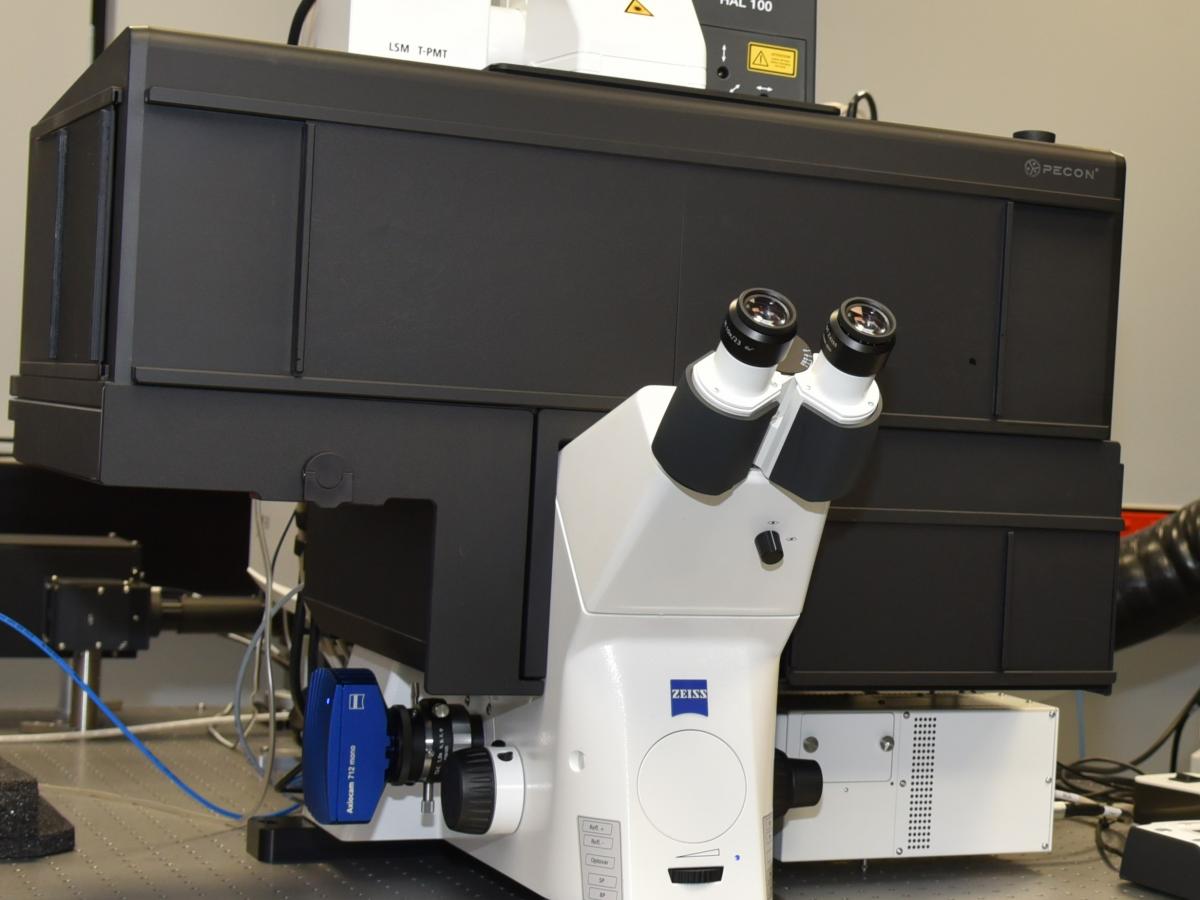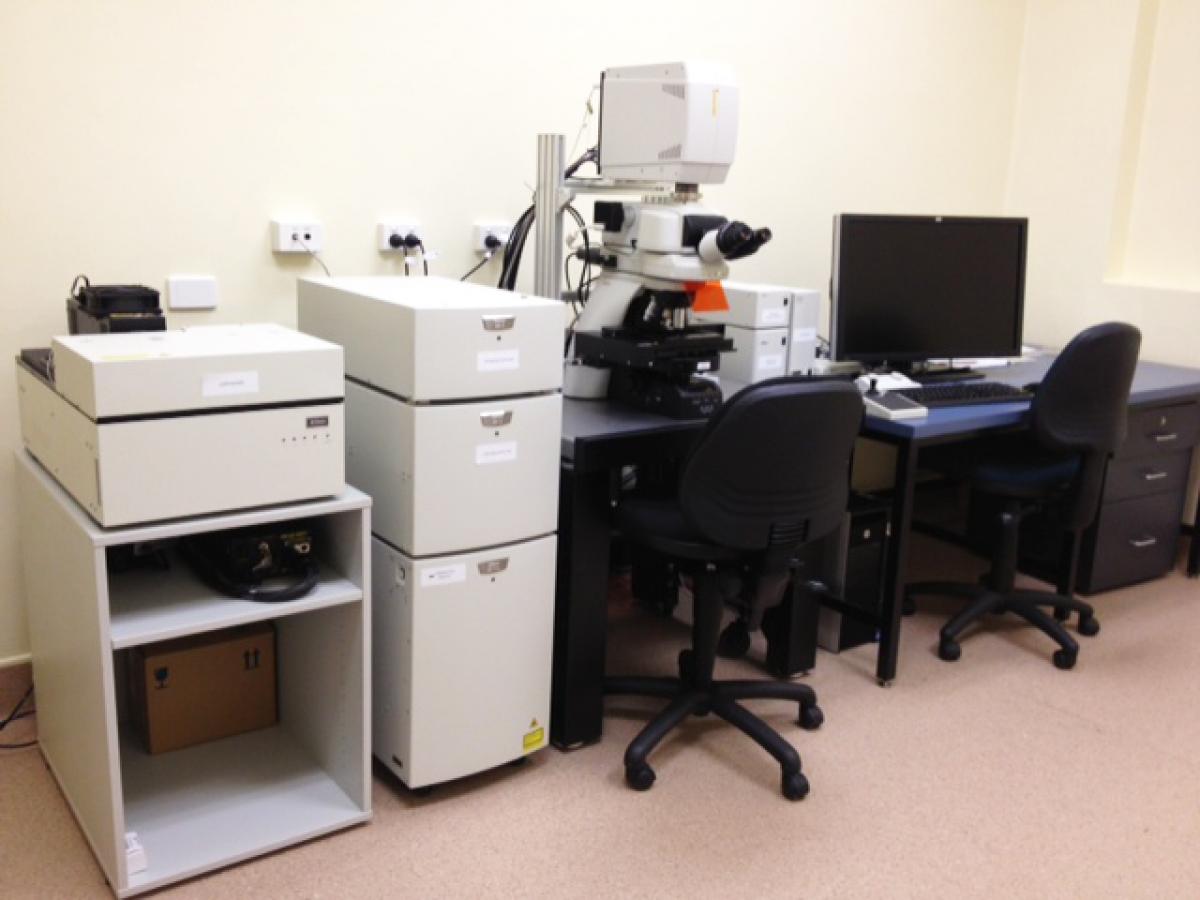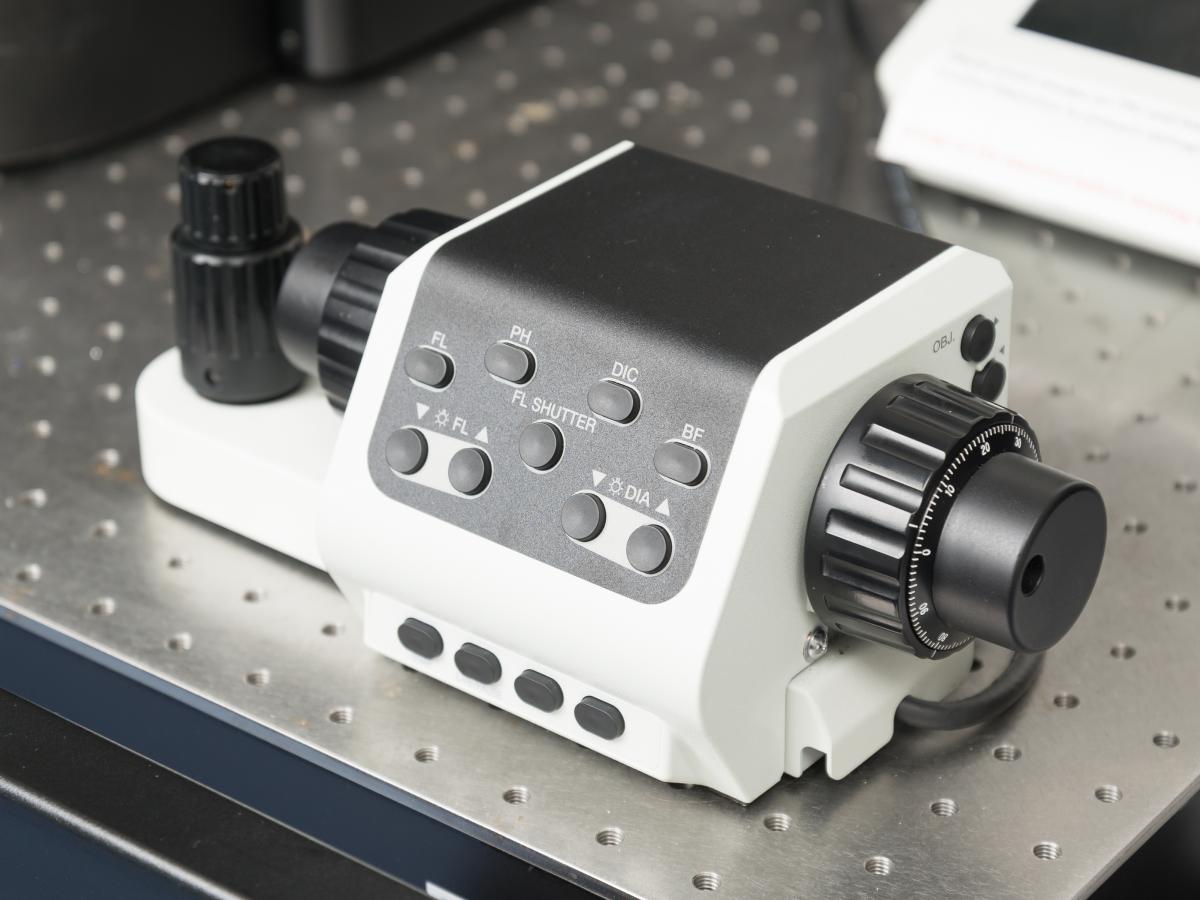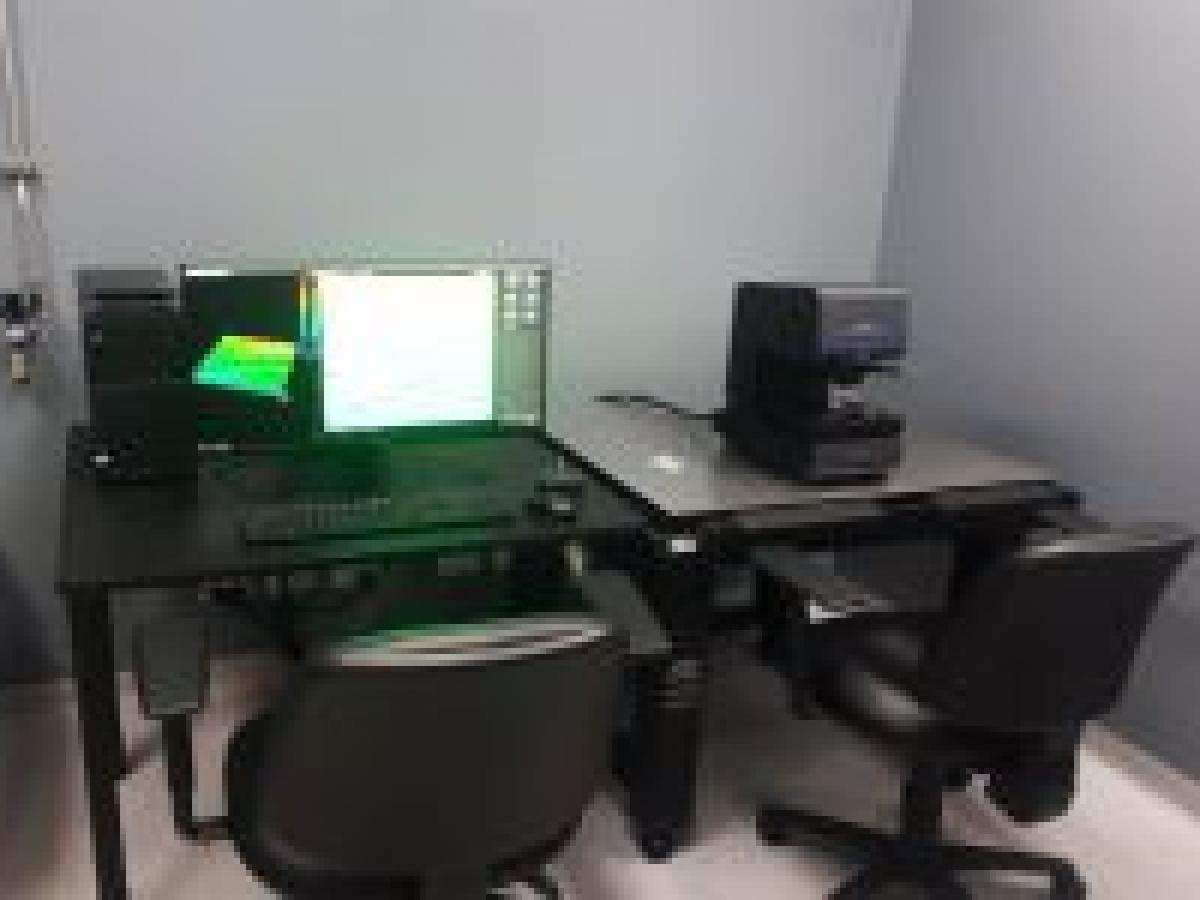Confocal Microscopes

Zeiss LSM980 Super-Resolution Confocal Microscope with Airyscan 2
Please contact Dr Jane Sibbons for further information.
Located at the Bioimaging Facility in the Molecular Life Sciences Building.
-
Information on the Zeiss LSM980 Super-Resolution Confocal Microscope with Airyscan 2
The LSM980 with Airyscan confocal microscope combines laser scanning microscopy with Airyscan technology to provide enhanced resolution, sensitivity, and speed for biological imaging. It enables researchers to visualize fine details, weakly fluorescent structures, and perform super-resolution imaging, expanding the possibilities of cellular and molecular research.
Capabilities
- Confocal with LSM plus
- Airyscan 2 with Multiplex SR-4Y, SR-8Y and CO-8Y modes
- Near Infrared Imaging
- Multiphoton imaging with Tuneable InSight X3 pulsed laser tunable from 690nm-1300nm
- Simultaneous Spectral Imaging
Combining laser point illumination, linear scanning, and detectors that can capture the signal in photon counting mode make the LSM 980 more than an imaging device:
- Raster Image Correlation Spectroscopy (RICS)
- Fluorescence Correlation Spectroscopy (FCS)
- Fluorescent Cross Correlation Spectroscopy (FCCS)
- Förster Resonance Energy Transfer (FRET)
- Fluorescence Recovery after Photobleaching (FRAP)
- Fluorescence Lifetime Imaging Microscopy (FLIM)
FEATURES
Objectives
Objective/Magnification
NA
Working distance
Brightfield/DIC
Fluorescence
Immersion
EC Plan-Neofluar 2.5x
0.085
8.8 mm
Brightfield only
UV-NIR
Air
Plan-Apochromat 10x/0.45 M27
0.45
2 mm
DIC
UV-NIR
Air
Plan-Apochromat" 20x/0.8 M27
0.8
0.55 mm
DIC
UV-NIR
Air
LD LCI Plan-Apochromat 25x/0.8 Imm Corr DIC M27
0.8
0.57 mm
DIC
UV-NIR
Water, Silicone, Glycerine and Oil
C-Apochromat
40x/1.2 W Corr M27
1.2
0.28 mm
DIC
UV-NIR
Exceeds in NLO-IR/2 photon
Water
C Plan-Apochromat 63x/1.4 Oil DIC M27
1.4
0.14 mm
DIC
UV-NIR
Exceeds in NLO-IR/2 photon
oil
Detectors
- LSM 980 34 channel spectral array including 32x channel GaAsP array and 2x MA-PMT flanking detectors
- NIR detector LSM 980 GaAsP detector
- NIR detector LSM 980 with GaAs technology
- BiG.2 Type A - 980 (2x individual GaAsP non-descanned detectors)
Lasers
- 405/ 445/ 488/ 514/ 561/ 594/ 639nm visible laser lines for confocal imaging
- IR 730nm laser
- transmission PMT detector for transmission imaging (using visible lasers)
- Spectra-Physics Insight X3 fs pulsed NIR single beam laser with tunable range from 690-1300nm
Incubation
- Temperature
- CO2
- O2 control
Stage
Fast Z-Piezo focus device with multiple stage inserts

Nikon A1R Laser Scanning Confocal with DS-Ri1 CCD camera
Please contact Dr Gwen Mayo for further information.
Located at Waite facility.
-
Information on the Nikon A1R Laser Scanning Confocal with DS-Ri1 CCD camera
The Nikon A1R laser scanning confocal is a research grade confocal microscope capable of high resolution imaging.
It has three solid state lasers (405nm, 561nm and 640nm) and a multi-line Argon gas laser (457nm, 488nm, 514nm).
The unique hybrid scan head has a galvano scanner for high resolution imaging and a resonant scanner for high speed acquisition. The resonant scanner allows high-speed imaging ranging from 30 fps (512 x 512 pixels) to 420 fps (512 x 32 pixels), and the galvano scanner features a maximum scan rate of 4 frames per second at 512 x 512 pixels. By employing a hexagonal pinhole, higher brightness than that of a circular pinhole is achieved.
The A1R confocal has two detectors. The “standard” 4 channel hybrid detector has two GaAsP PMTs and two normal PMTs. The spectral detector has wavelength resolutions of 2.5, 6, and 10 nanometers, and a 32-channel multi-anode photomultiplier. Spectral unmixing allows separation of closely overlapping fluorescence spectra and the elimination of autofluorescence. Real time unmixing can be applied during image acquisition.
The Ni-E motorized microscope is sited on TMC vibration isolation table. The microscope has two dry objectives (10X Plan Apochromat Lambda; 20X Plan Apochromat Lambda), two water immersion objectives (40X Apo LWD WI λS; 60x Plan Apo VC WI) and one oil immersion objective (100X Plan Apochromat Lambda H Oil, N.A. 1.45, W.D.0.13mm). Fluorescence filters are longpass: V-2A (Ex 330-380, DM 400 BA 420); UV-2A (Ex 380-420, DM 430 BA 450); B-2A (Ex 450-490, DM 505 BA 520); G-2A (Ex 510-560, DM 575 BA 590).
The microscope has a zooming port and DS-Ri1 colour cooled digital camera for widefield (brightfield and fluorescence) imaging. An additional GFP band-pass filter is available for widefield imaging. The NIS-Elements C control software platform incorporates visualization, image analysis, processing and data management.
For more information on the manufacturer visit Nikon web site.

Olympus FV3000 Confocal Microscope
Please contact Dr Agatha Labrinidis (AHMS) or Dr Gwen Mayo (Waite) for further information.
Located at Adelaide Health & Medical Sciences Building and Waite Facility.
-
Information on the Olympus FV3000 Confocal Microscope
The Olympus FV3000 Laser Scanning Microscope is a fully spectral microscope with a brand new TruSpectral Technology that combines high performance imaging capabilities with customisable software that is easy to use. Main features include: Fast and accurate imaging using a high-speed scanners, bright fluorescent imaging of even dim samples due to high-sensitivity detectors and improved observation reliability achieved by precise spectroscopy and newly developed time management system.
APPLICATIONS
The FLUOVIEW FV3000 series is designed to meet some of the most difficult challenges in modern science. Featuring the high sensitivity and speed required for live cell and tissue imaging, the FV3000 enables 2D-6D (x,y,z,t,λ,p) macro-to-micro imaging of cells, tissues, and small organisms. With an intuitive and adaptable user interface, the FV3000 supports complete workflows from image acquisition to processing and analysis. Particular attention has been paid to the needs of cell biology, cancer research, and stem cell research, and with two new upright configurations, the FV3000 is also poised to meet the needs of neuroscience, electrophysiology, and developmental biology.FEATURES
- The FV3000 enables macro scale imaging from 1.25X while retaining capabilities of super resolution imaging at up to 150X magnification.
- Silicon immersion objectives for accurate 3D imaging.
- Resonant scanner to capture highly dynamic biological processes.
- Multi-Dimensional Time-lapse with Z-drift compensator.
- 3D Mosaic Imaging
CAPABILITIES
A wide range of live and post processing analysis functions are available to enhance data production:- Fluorescence spectral unmixing (up to 16 channels)
- 2D data histogram display
- Ratio imaging and IMD display
- Fluorescence intensity and time-lapse measurements
- Rolling average processing
- Projections (including maximum intensity Z)
- Z gap correction
- Image editing (including individual colour setting, pseudo-colour, and graphic/text annotation)
- FRET
- FRAP
- Super-Resolution
- Noise Reduction
Featured cellSens Image Processing and Analysis Functions
- Constrained Iterative Deconvolution
- Count and Measure (Object Segmentation, Measurement, Counting, Classification)
- Kymography (Velocity Measurements)
- One-click macros for automated processing and analysis

Olympus LEXT OLS5000 Profilometer
Please contact Dr Benjamin Wade for further information.
Located at Frome Road.
-
Information on the Olympus LEXT OLS5000 Profilometer
The Olympus LEXT OLS5000 is a laser confocal microscope designed specifically to measure shape and surface roughness of samples at the submicron level.
It is a complementary tool to that of AFM which is traditionally and predominantly used for high resolution height and surface roughness measurements of much smaller areas. The instrument utilises a 405nm violet laser and a pinhole aperture much the same as traditional confocal microscopes, with the addition of a MEMS resonant scanner used for XY scanning of the UV laser for low distortion and aberrations.
When measuring height of the sample, the microscope acquires multiple confocal images through a Z range defined by the user. Based on focus position (Z) and detected light intensity, light intensity variation curves are created for each pixel. Following this a height information/image can be reconstructed, along with an “extended” image which is an image of the sample surface in which the entire surface is in focus.
